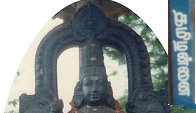Tamil Alphabet
Tamil orthography consists of twelve vowels and eighteen consonants and each of these sounds is represented by an unique letter. Alphabet system of this language is believed to be a derivation from the ancient Brahmi script (5th century BCE to 4th century BCE), which serves as a source for most of the Indian languages. Tamil is a syllabic language where the consonant/vowel combination is represented by a composite form of consonant and a secondary symbol for each vowel. In most cases, a secondary symbol is added either before or after the consonant to make up the syllable, but in a few cases the consonant is slightly modified to form a new shape. Thus, syllables in Tamil are derived by a combination of twelve vowels and eighteen consonants which form a total of two hundred and sixteen different characters or otherwise called graphemes.
To understand how a syllable is formed in Tamil, consider the Tamil proper name Balu,
which is written in English with four different letters, each corresponding to either a consonant or a vowel
and combining to form syllables (hence, 'B' and 'a' form the syllable 'Ba').
In Tamil 'Balu' is written as the combination of
two symbols each of which represents one syllable, Ba and lu:
பாலு, where the two symbols are பா and லு. The long vowel ஆ (aa), when combined with a consonant
is marked by the a secondary symbol along side of the 'pure' consonant (i.e., the consonant in isolation or when geminated); e.g.,
ப் + ஆ --> பா. Similarly, the short vowel உ (u) is combined with the pure consonant ல் (l) to form
the syllable லு (lu). Thus, in Tamil the syllables are made either with a secondary symbol placed either before or after pure consonants, or with a change in the original shape of the
consonants.
Tamil Vowels. Listen to all Vowels:
Vowel sounds are produced with the tongue placed in different parts of the mouth. When pronouncing the vowels இ, எ, அ, ஒ, உ i, e, a o, u, tongue moves from back part of the mouth to the front. Based on the tongue positions, the vowels இ i and எ e are named front vowels, அ a a mid vowel and ஒ o and உ
u back vowels.
Short Vowels
| Letter | Pronunciation |
|
அ | a as in that, gun |
 |
இ | i as in it, this |
 |
உ | u as in book, took |
 |
எ | e as in then, when |
 |
ஒ | o as in hotel, motel |
 |
Long Vowels
Short vowels have their long counterparts ஈ, ஏ, ஆ, ஓ, and ஊ ii, ee, aa oo, and uu. Unlike the short vowels these sounds are produced with the release of air from mouth for a slightly extended period of
time than their short counterparts, and hence they are called long vowels. Following table shows a list of long vowels with example English words containing each of these sounds.
| Letter | Pronunciation |
|
| ஆ | aa as in got, taught |
 |
| ஈ | ii as in sweet, treat |
 |
| ஊ | uu as in tool, cool |
 |
| ஏ | ee as in tale, there |
 |
| ஓ | oo as in coat, boat |
 |
Dipthongs
Besides the above ten short and long vowels, there exists two other vowles called
dipthongs. They include ஐ ai  as in 'kite' and ஔ au as in 'cow'.
as in 'kite' and ஔ au as in 'cow'. These sounds are produced by a combination
of two voweles namely a and i; and a and u respectively. While making these sounds,
tongue moves from the position of the first vowel to the other. In spoken Tamil,
however, these two dipthongs are produced with the combination of vowel and
corresponding glides namely y and v respectively, as in அய் and அவ்.
These sounds are produced by a combination
of two voweles namely a and i; and a and u respectively. While making these sounds,
tongue moves from the position of the first vowel to the other. In spoken Tamil,
however, these two dipthongs are produced with the combination of vowel and
corresponding glides namely y and v respectively, as in அய் and அவ்.

